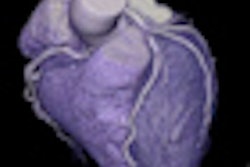
Over the past decade or so, there's been a lot of discussion among healthcare providers throughout the world about the adoption of information technology. But how to measure and assess what's been done, and put this in a format that allows for comparison?
In Europe, this complex issue is being tackled by HIMSS Analytics Europe, launched in June 2010 as a spin-off of HIMSS Analytics, a wholly owned, not-for-profit subsidiary of the Healthcare Information and Management Systems Society (HIMSS). In honor of the organization's second anniversary, AuntMinnieEurope.com talked to managing director Uwe Buddrus to learn more.
 Uwe Buddrus, managing director of HIMSS Analytics Europe, is celebrating the organization's first two years.
Uwe Buddrus, managing director of HIMSS Analytics Europe, is celebrating the organization's first two years.
HIMSS Analytics itself isn't that old. It was founded in 2004 to provide data and analytic expertise to support improved decision-making about healthcare IT. But its existence represents more than two decades of data compilation by Sheldon Dorenfest, a healthcare IT pioneer who developed one of the first commercial electronic medical record (EMR) systems. In 1976, he began to collect data about hospitals' IT implementations in the U.S. and Canada, parlaying this over the years into a detailed database of 1,500 integrated delivery networks comprised of 40,000 facilities.
The Dorenfest database, combined with the HIMSS solutions toolkit that acquired data from a variety of sources that monitored healthcare IT trends and sales, formed the core of HIMSS Analytics. The organization created an eight-tier EMR adoption model, known as EMRAM. Since this time, in addition to detailed data that are regularly collected, all hospitals in the database are assigned a level on the EMRAM scale.
Starting in 2008, a similar initiative was under way in Europe. The Hospital IT Network, whose mission was to create a business-to-business network of healthcare IT vendors and their clients, was conducting comparative IT adoption benchmarking. HIMSS purchased this company in June 2010.
The work of HIMSS Analytics Europe, headquartered in Leipzig, Germany, is to help hospital directors, IT executives, and clinicians better understand their own healthcare organizations IT operations, and by utilizing anonymized data, understand how they compare to others. A European-formulated EMR adoption scale was implemented to help hospitals, health government agencies, and vendors to make practical assessments of IT activities.
Achievements to date
With the financial backbone of HIMSS, ongoing data collection from hospitals throughout Europe has escalated dramatically. The staff of HIMSS Analytics Europe continuously collects data from individual hospitals and hospital groups, using telephone, online, and/or electronic spreadsheet-based self-completion surveys. To date, information has been collected for up to 40% of hospitals in countries with the fewest amount of hospitals, and at least 10% for countries with more than a thousand acute bed hospitals.
"We have focused our initial efforts on acquiring data from hospitals in 13 countries," Buddrus explained. "These include the five countries with the largest populations and numbers of healthcare facilities, specifically France, Germany, Italy, Spain, and the U.K. The other countries are Austria, Belgium, Denmark, the Netherlands, Poland, Portugal, Sweden, and Switzerland." The organization was recently contacted by a Norwegian regional health authority, and Buddrus expects that as a result of this interest Norway will be added to the core group.
HIMSS Analytics Europe has developed 12 country-specific hospital information system profile reports. Each profile reviews 44 different software functionalities. Profiles provide a comprehensive list of key hospital demographics of the country, identify key drivers in hospital IT deployment, and include insights on trends of hospital budgets. Profiles have been published for all of the core countries except the U.K.
Seven country insight reports have also been prepared for Denmark, France, Germany, Italy, Spain, Sweden, and the U.K. These describe in detail key performance parameters and indicators of a country's hospital IT market.
"Much of our effort has been focused on developing a viable EMRAM model for Europe. While the underlying logic of the HIMSS North America model applies for any acute care facility anywhere in the world, it is not directly transferable to Europe. From its inception, we knew that changes would be needed, but only through intensive research have we developed an appreciation of very important differences," Buddrus noted.
The EMRAM model
The EMRAM Europe model identifies the levels of EMR capabilities ranging from limited ancillary department systems through a paperless EMR environment. HIMSS Analytics Europe has developed a methodology and algorithms to automatically score hospitals in its database relative to IT-enabled status. It uses this to provide peer comparisons among hospitals, which now number more than 1,000 with complete datasets and another 500 or more with nearly completed datasets.
 Source: HIMSS Analytics Europe, November 2010
Source: HIMSS Analytics Europe, November 2010Overall, approximately 15% to 20% of all hospitals are included in the database, but with great variances in country coverage. Italy, Portugal, and Spain are among the most complete to date. Hospitals that provide their data are given their assessments free of charge.
Buddrus cited a comprehensive PACS implementation as one example of differences in stage (0 through 7) levels of EMR adoption. "Europeans have a much stronger focus on digital radiography. For this reason, European hospitals must have a complete electronic medical image management implemented to reach stage 5. In North America, this is a requirement for stage 6," he said. "However, in the United States, there is much more focus on medication safety, and it has become an IT necessity at lower EMRAM stage levels."
This doesn't mean however, that Europeans aren't equally interested in medication safety. The intrinsic difference is the way that medication is dispensed and administered, he explained. In the U.S., virtually all hospitals have pharmacies that dispense medication in unit doses. In Europe, standard prescription medications are often stored and dispensed by nurses at the care wards. Additionally, medications are often packaged in unit doses, each identified by name, dose, and expiration date. Whereas many U.S. hospitals use barcodes to make sure that each patient is receiving the right medications prepared by an in-house pharmacy, alternative methods predominate in Europe.
Using an electronic medication administration record, the caregiver verifies the identity of the patient, the medications to be given, the medications in hand, and that these precisely match the record. The caregiver then documents all of it. Depending upon the country, there may not even be an in-house pharmacy. Medication may be obtained by wards directly from the materials management stock department of a hospital.
The impact of this to the EMRAM model is dramatic. A pharmacy information system is a mandatory requirement to reach stage 1 for the North American model. If this was applied to Europe, it would mean that many hospitals could not pass stage 0. Thus, the model was changed to eliminate the necessity of an in-house pharmacy by introducing the option of electronic prescription information exchange and validation with external pharmacies.
"We're still in the learning process of modifying individual elements of the model based on a country-specific situation, but always in a way that it will still accurately provide cross-country comparisons," Buddrus said.
European healthcare IT implementation trends
Of the 13 countries HIMSS Analytics Europe tracks, the country whose hospitals have the highest number of high EMRAM model scores is Spain. In spite of the economic crisis, Spain has invested heavily in healthcare IT infrastructure.
"Spain made a quantum leap since 2004, when I first began to evaluate its healthcare IT adoption. Then I would have categorized it as a developing country. Now it is one of the leading healthcare IT implementers in Europe. Forty percent of its hospitals are at stage 5. Over the last three years, Spain has shifted the majority of hospitals from stage 3 to stage 5," Buddrus noted.
He attributes the budget allocated for healthcare IT as stimulus for this adoption, 2.1% of the total hospital operating budget. By comparison, Italy's is 1.4%, and Germany's is also 1.4%, down from 1.8% three years ago. The austerity, cost-cutting measures throughout Europe represent a major setback to expanding the scope of healthcare IT technology. These products aren't static. They require upgrades and replacements, which take budgetary priority over new projects.
Even so, Buddrus predicts that there will be significant investment activity in clinical data warehouses, business intelligence software, and outcomes and quality management software. He predicted that between 10% and 30% of acute care hospitals are planning to make investments in at least one of these three areas.
About 50% to 80% of Western European hospitals have implemented clinical data warehouses. Between 8% to 10% of hospitals in Sweden and Spain intend to implement data warehouses, and up to 24% of Austrian hospitals plan to do the same. When completed, this will bring installation rates up to more than two-thirds of the hospitals in the core 13 nations.
Investment in business intelligence software used for financial analyses, as well as making a hospital more efficient, provide better healthcare treatment, and produce better outcomes, spans a broad implementation spectrum. Up to 90% of all reporting hospitals in Sweden use this software; utilization ranges from 20% to 25% in Austria, German, and Italy. Business intelligence software is an investment target for the remaining 10% of hospitals in Sweden and up to 29% in Denmark.
Software relating to outcomes and quality management is the least widely implemented but has the highest average investment rates. Installation rates range from just 10% in Austria and Italy up to 55% in the Netherlands. Legislation passed in Germany has given a boost to implementing electronic quality management programs, superseding investment in business intelligence software.
"These trends are clearly in line with the status and development of EMR adoption. The more clinical data becomes available in electronic format, the more it becomes important to store it in a way that enables linking measurement of clinical activity to economic and clinical outcomes," he concluded.
HIMSS Analytics staff plans to contact every hospital in Europe, but that the organization welcomes hospitals that take the initiative to make contact first. The reward is the deliverable: an assessment of how the hospital is rated on its path to complete electronic healthcare implementation, and a benchmark to compare against other anonymized participants.



















